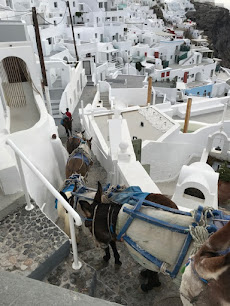CAPITALE DE NOEL
From Bourgogne we drove north to Alsace on the German border and the city of Strasbourg, FR.
As you probably know, over the centuries Alsace and Lorraine to the east have gone back and forth between Germany and France. After WWII it was "returned" to the French. Still a very sensitive topic on both sides I found out. Interestingly, in my genealogy research my 3G Grandfather (that's three Greats) on my dad's side, was born in Gerstheim, Elsace (Alsace) in 1769. This is just a small non-noteworthy village on the Rhine about 20 km south of Strasbourg. He immigrated to Neppendorf, Hungary (then Austria/Hungary Empire, now Romania). This region of Transylvania, surrounded by the Carpathian mountains, maintained a large community of ethnic Germans for centuries until 1989 after the fall of the Soviet Union. I visited my relatives there in 1980 when still communist controlled; and again in 2007 with Robin, my brother and sister, and my second cousin once removed Maria, whom I met in 1980. She and most ethnic Germans left Romania for Bavaria after the fall. Now there is only a museum to that community in a 13th century church where my Grandfather was baptized. In the museum we found photos of my paternal grandparents and great-grandparents. Shocking to travel 7000 miles to a small town in a remote foreign country and see photos of your relatives in a museum, even more so of yourself shown by a local relative that our grandparents sent to their grandparents.
 |
| 2007 photo of my brother, me, sister, and cousin being shown photos of us as teenagers by distant relative who saved them from her grandparents |
But I digress. We stopped in two classic Alsatian towns along the way to Strasbourg: Colmar, and Riquewihr. (Colmar is shown on map above, Riquewihr is smaller and north of that.) Both German and French are spoken in Alsace and the half-timbered buildings are definitely more Germanic than French. This construction type was for the middle class of the time, the burghers used stone (the poor just huts). It's basically post and beam with diagonal bracing for rigidity. The infill is called "wattle and daub". Wattle is a woven lattice of wooden strips, most likely small branches, daubed with a sticky combination of wet soil, clay, sand, dung, and straw - like a plaster. Used for thousands of years and still maintained in Europe's middle ages buildings.
 |
| Half-timbered buildings in Colmar |
 |
| Hard to see, but many roofs in Colmar are adorned with Teddy Bears |
These towns are so sweet during Christmas you feel you might get diabetes. One WWII note is that the Allies made the conscious decision not to bomb Colmar as it was too lovely and historic, and not that strategic like Dresden and so many others that were obliterated.
 |
| Riquewihr |
After visiting each town for a few hours, we arrived after dark in Strasbourg, the third largest city after Paris and Lyon. We found our AirBnB just outside the historic district. It was our most expensive place, and the least comfortable. Teigan had to sleep on a fold out bed that took up the entire kitchen/living room. And it wasn't comfortable. But it was in a great location. Fortunately we spent little time there.
Strasbourg is noted for its Christmas Markets since the sixteenth century! Thus its brand Capitale de Noel. Robin's kind of place, she was in heaven!
The historic district is located on several islands formed by the river and man-made canals to channel water needed for their tanneries. To enter the island markets you pass through a barricade on the bridge where they scan your EU covid app and enforce wearing a mask - and security reminds you if it slips down.
 |
| Bridge over the river/canal to the Christmas markets |
 |
| Bridges across several canals and the historic German Fortified Towers with the Cathedral in the background |
 |
| Gluhwein and Chaud Vin stalls are everywhere advertising this hot spiced wine in both German and French. |
There are laser cut wooden ornaments and shelves of small half-timbered buildings that are incense burners. There were also numerous stalls selling figurines of peasants, clergy and nuns from the middle ages complete with assorted farm animals. They come in specific scales with peasant buildings or nativity scenes in similar scales. "Collect them all". For a foreigner, pretty classy stuff compared to US trinkets.
 |
| An army of peasant and clergy figurines in all sizes |
As we wandered the markets we'd periodically get a vista of the cathedral and its rose window. It's enormous.
 |
| Glimpse of Strasbourg Cathedral down a market street |
It's in a late gothic style and very imposing. Probably one of the most spectacular cathedral's we seen, and that's a lot. (The interiors less so). The spire is 466' tall and was the highest in Europe for over 200 years. It's now the sixth tallest church in the world and is the highest extant from the middle ages. It appears to me that it was never finished. Most cathedrals of that era have a symmetrical facade, as does the Strasbourg Cathedral below the spire, except it only has one spire. But in a way, only having one makes it appear all the taller.
 |
| Cathedral up front and personal dominating the market |
 |
| Market Square with enormous full tree. In contrast to what we'll find in Trafalgar Sq. |
Next Post: Christmas from London







































